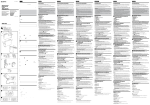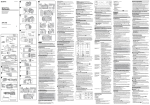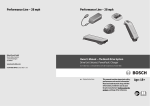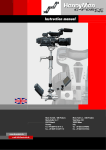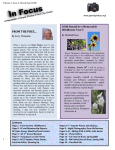Download Wiley Digital Travel Photography Digital Field Guide
Transcript
1 Exploring the Digital Camera C H A P T E R ✦ ✦ ✦ AL ✦ In This Chapter RI T Digital camera categories MA TE he digital camera you own right now is probably the perfect tool to capture memories of your trip. All you may need are some accessories that can give you some extra capabilities or will make your photography a bit easier. If that’s the case, you’ll find some suggestions for equipping yourself in Chapter 2, and some accessorizing tips in Chapter 5. GH TE D This chapter is aimed at familiarizing you with digital camera features that are most useful when taking travel and vacation pictures. If you’re thinking of upgrading to a newer or better camera, you’ll find some information on the various categories available today, and what they have to offer. CO PY RI Although it’s a safe assumption that as readers of this book you already own the digital camera you’ll be using on your travels, it’s still worth devoting a few pages to the ideal features and capabilities you’ll need. After all, a very special journey may prompt you to buy a new, very special camera. Or, you might find that several members of your traveling party want their own digital cameras so they can capture their own memories. For most of us, a digital camera isn’t a lifetime investment. It’s something we buy in the same way we purchase a computer, as a tool that gives us the advantage of current technology, but with the full expectation of replacing it somewhere down the road with a smaller, better, more powerful, more flexible device, at a lower cost. No matter what type of digital camera user you are — veteran, beginner, or someone who hasn’t dipped a toe into the digital waters yet — and whether or not you’re thinking about upgrading, this chapter will help you. Considerations for a New Camera ✦ ✦ ✦ ✦ 16 Part I ✦ Becoming Familiar with Your Traveling Camera Digital Camera Categories Until recently, most digital cameras could be neatly classified solely by the number of megapixels, or resolution, they offered, because all the other useful features and prices often followed in lock step with the camera’s resolution. Today, however, you find cameras with around 6 megapixels ranging from simple point-and-shoot models to advanced SLRs with interchangeable lenses. You can’t tell the players without a program, but you can discern their differences by their features and layouts. Your digital camera will be one of these types: ✦ Basic point-and-shoot models. You frame the picture through a simple optical viewfinder or a small LCD screen, press the shutter release, and these cameras make all the other decisions for you. Generally priced in the $100-$200 range, these basic 4- to 6- (or more) megapixel (millions of pixels, or picture elements) models have a 3X zoom lens that may not be quite wide enough for photographing interesting buildings and monuments in tight quarters, nor have enough telephoto magnification to capture distant subjects. The built-in flash unit may be good for shots from 5 to about 11 feet. Focusing is automatic, with no options other than a close-up mode. ✦ Intermediate point-and-shoot cameras. Most travel cameras sold today fall into this category, with models having 5 to 7 megapixels and prices in the $200-$400 range. They appeal to casual and slightly more serious photographers who want sharp, clear pictures, and a bit of versatility in their cameras. Zoom lenses range from 3X to 6X. In addition to automatic focus and exposure, there may even be a few manual settings. These can include the ability to choose the shutter speed or lens opening , exposure adjustment for photos taken facing the sun, or full manual control. Anyone who is not a dedicated photo buff can probably take any travel picture he or she cares to create with a camera of this sort. ✦ Advanced point-and-shoot models. More advanced models attract travelers who want more options and features. Those with $400$600 can buy an 8- to 9-megapixel (or more) camera with a 6X to 12X or longer zoom (magnification) range, more manual controls, and interesting bonus features. These cameras appeal to those who realize they can take better and more interesting pictures with a digital camera that has more options. Such cameras are stuffed with multifunction buttons and dials, lots of modes, dozens of menus, and thick manuals. You’ll find goodies like time-lapse photography, burst modes that can squeeze off six to 10 shots at 2 frames per second or faster, and in-camera editing/ image-enhancing features. These extra features can be very handy while traveling without a computer. ✦ Photo enthusiast models. These are sometimes called “prosumer” cameras, and include non-interchangeable lenses with generous zoom ratios (often extending from true wide angle that’s the equivalent of 24mm for those of you familiar with 35mm camera lenses) to ambitious telephoto (up to the Chapter 1 ✦ Exploring the Digital Camera 17 1.1. An enthusiast camera may have both a large back-panel LCD as well as an internal electronic viewfinder (EVF). equivalent of 300-360mm — truly a long reach). You can spend $600 to $1,000 for an 8- to 10-megapixel camera that probably has a large back-panel LCD (up to 2.5 inches) and a second, internal LCD (called an electronic viewfinder, or EVF) that shows you almost exactly what the lens sees. These are the cameras that advanced amateur photographers favor, because their lower cost frees up money to purchase extra accessories. They are also the cameras that pros sometimes use on weekends for their personal photography or which they purchase as cheap, extra cameras to supplement their good equipment. to shoot in lower light levels. The dSLR also has faster performance, with little of that frustrating lag that delays the actual picture-taking once you press the shutter release button. Digital SLRs cost around $700 to $1,300 (add another $100 to $300 and up for a lens) for the prosumer models, and $1,300 to $5,000 or more for those suitable for advanced amateurs and professionals. Resolution for dSLRs ranges from 6 to 16 megapixels. ✦ Digital SLRs. The digital SLR (single lens reflex) is the camera of choice for serious photo hobbyists and professional photographers. They offer unlimited optical flexibility because the lens can be removed and replaced with another lens that is wider, longer, focuses closer, or has the ability 1.2. Digital SLR cameras feature interchangeable lenses, excellent performance, and lots of extra features. 18 Part I ✦ Becoming Familiar with Your Traveling Camera Working with what you have Even if you’ve been using your camera for awhile, it’s a good idea to explore the typical features as they relate to travel photography. This section helps you refamiliarize yourself with your own camera from a travel photography perspective. ✦ Resolution. Resolution expresses the number of individual picture elements, or pixels, a camera can capture, usually specified in megapixels. The resolution determines the maximum size of the prints you can make from your digital camera’s images or whether you can crop out a small section of an image and enlarge it. If you’re just going to make small prints of your travel pictures you don’t need as many megapixels (4 to 5 megapixels is plenty), and being frugal with resolution allows your memory cards to hold more images before they fill up. ✦ Lens. The lens mounted on your digital camera determines the relative magnification of your image. Most digital cameras use zoom lenses that can be adjusted to make the image larger or smaller, so you can shoot different subjects without the need to get closer or back away. This quality is usually described in terms of focal length, expressed in millimeters, and almost always given as the equivalent focal length if the lens were mounted on a 35mm film camera. Equivalent focal lengths of 35mm to 40mm or less are considered wide-angle lenses; those from 40mm to about 55mm are considered normal lenses, and anything with a longer focal length is referred to as a telephoto. Digital SLR (single lens reflex) cameras have the ability to substitute a different lens for the one mounted on the camera. The range of your lens is important for travel photography. You frequently need to use a wide-angle setting to take in all of a building or monument, while a telephoto setting brings you closer to a distant subject. ✦ Focus. Another characteristic of the lens and the camera it is mounted on is the ability to focus sharply at a given distance. All digital cameras and their lenses can focus from a few feet to the horizon (infinity), but some can focus closer, down to an inch or less from the front of the lens. This gives you the ability to shoot close-up, or macro, pictures. The simplest digital cameras use a fulltime autofocus system to set the focus point for you. More advanced cameras let you specify the zone within your picture frame to be used for focus or to focus manually. Travel photos can vary from distant subjects to fine details, so a good focus range and efficient autofocus system are desirable. ✦ Exposure. An autoexposure system keeps your photos from being too light or too dark. The system sets the amount of time the sensor is exposed to light (the shutter speed) and how much light is admitted through the lens (the aperture or f-stop.) Such exposure systems may use a complicated matrix of zones within your image area to determine ideal exposure or let you opt to measure exposure from a smaller area of your choice. A good exposure system allows Chapter 1 ✦ Exploring the Digital Camera you to expose your travel photos flexibly, say, to create a silhouette or other effect. ✦ Viewing System. Digital cameras have one of four kinds of viewfinders: an LCD that shows an image as currently captured by the sensor; an optical window you can use when the light is too bright to view the LCD on the back of the camera; an electronic viewfinder (EVF) inside the camera that is similar to the back-panel LCD, but shielded from external light; and a through-the-lens optical viewfinder (found in dSLRs) that uses a mirror to present an image to you before exposure. The mirror flips up to allow the image to continue to the sensor during exposure, and then returns to its original position to restore your view in a (literal) blink of an eye. Some cameras may have only a back-panel LCD, or may include the LCD plus an optical 19 window or internal EVF. With digital SLRs, viewing is always through the optical viewfinder; the back LCD is used only for reviewing photos. Because so many travel photos are taken outdoors, digital cameras with an LCD as their only viewfinder are often less desirable. ✦ Performance. Your camera’s performance can be measured by how quickly it operates, which can be crucial in travel photography because you often don’t have a lot of time to waste. In some situations, you need to take the photos you want and then move on. In others, you see a fleeting moment and want to capture it instantly without waiting. Important performance parameters can include how long you must wait after you turn on your camera before you can take a picture (3 seconds or more is probably too long in most travel settings), and how quickly 1.3. A camera that has a large LCD on the back, but no optical viewfinder, is great for reviewing your photos but may be difficult to use in bright sunlight. 20 Part I ✦ Becoming Familiar with Your Traveling Camera you can take your next picture (anything more than 2 or 3 seconds will become frustrating). Fast exposure measurement and autofocus, speedy electronic flash recycling, and quick storage of images to your memory card (so you can keep taking many pictures in sequence) are all important when you’re in a hurry — or sometimes even when you’re not. ✦ Flash Range. Electronic flash needs little explanation. The image of the tourist wandering around, flashing a camera incessantly, is one of the reasons why electronic flash is banned from so many venues. Flash pictures rarely provide the best image of your subject in any case. Even so, there are times when flash is useful, particularly to fill in dark shadows outdoors in full daylight. For those times when you do need to use flash, you’ll want a flash that has enough power to illuminate your subject at a decent distance (12 feet at the minimum.) Generally, the smaller the camera, the more puny the output of its flash. That’s not because powerful flash tubes won’t fit in tiny cameras. The real reason is that an electronic flash uses a lot of power, and small cameras usually have correspondingly small batteries. That’s another reason why you should try to rely on flash as little as possible for your travel photos. Naturally lit pictures are...more natural...and should be your first choice. camera. I list five easy ways to improve your travel photos here, but there are more suggestions in Chapter 5. ✦ Wide-Angle/Telephoto Attachments. Point-and-shoot cameras don’t have interchangeable lenses, but many of them can be fitted with wide-angle and telephoto attachments that provide a broader or longer perspective. These fasten to the front of the lens and may cost $100 or less. If you don’t own one of those “superzoom” (8X to 12X zoom) cameras, an attachment of this sort can be a good investment, perhaps even postponing the need to replace your camera for a few years. 1.4. This attachment fits on the front of a point-and-shoot camera’s fixed lens and increases its wide-angle perspective. ✦ External Flash. An external flash Simple enhancements to improve your travel hardware Here are some things you can do to upgrade the capabilities of your digital travel unit (if your digital camera can use one; digital SLRs and many advanced point-and-shoot cameras have the correct connectors, while others can use a “slave” flash Chapter 1 ✦ Exploring the Digital Camera that has its own triggering unit) provides more power and lets you use creative techniques. 21 the self-timer ticks off while you frantically run to get into the picture. If you don’t want to take a tripod on your trip, a soft beanbag (like those your kids toss around at a school carnival) may be the next best thing. Plop the bag down on a suitable surface, nestle your digital camera into the beanbag’s embrace, and then proceed to take your picture. Just be sure to keep a lookout for dishonest folk who may cast a covetous eye on your beanbag and unattended camera! ✦ Lens Hood. One way to dramati- 1.5. An external flash can be attached to the camera, or it can be removed and used while attached to the camera with a cord to allow lighting your subject from a different angle. ✦ LCD Hood. If you have difficulty viewing your back-panel LCD under bright light, a custom-fitted hood can shield your viewfinder from ambient illumination. Hoodman (www.hoodmanusa.com) has easyfasten hoods for most digital cameras and video camcorders. If your camera has only an LCD with no optical finder option, this may be the best investment you can make. ✦ Beanbag. Sometimes you need to steady your camera to shoot at a slow shutter speed under dim illumination. Other times you just want your camera to stay put as cally improve the quality of your images when shooting images in the direction of the sun or other bright light is to mount a hood on your lens. Most digital SLR camera lenses are furnished with a hood, but you can usually find one to fit many intermediate pointand-shoot or advanced digital cameras, too. The hood reduces flare and improves the contrast of your pictures, and serves as a modicum of protection should you accidentally swing your camera into an object. Considerations for a New Camera The ideal camera for travel photography varies, depending on who is doing the shooting. Some travelers want the smallest camera possible, something that can be slipped in or out of a pocket on the spur of the moment to photograph an interesting monument or unexpected scenic wonder. Others prefer a camera with maximum megapixels, because the extra detail all that resolution supplies makes it possible to enlarge the very best shots to sizes suitable 22 Part I ✦ Becoming Familiar with Your Traveling Camera for framing and display in a personal photo gallery, or to crop out all but a tiny portion of the image, creating a whole new photograph from the contents of your original shot. Or, you might simply want a digital camera that has features that make sharing your pictures easier. There are cameras that make e-mailing photos back home as easy as connecting the camera to a computer in an Internet café and pressing a few buttons. Tip Because deciding on the ideal digital camera for travel can be daunting, it is a good idea if you can narrow the field a bit. Or, if you are just looking to upgrade, and you want recommendations for specific models, you can read the evaluations found on the most highly regarded Internet review sites, such as www.dpreview.com or www. cnet.com. To arrive at the ideal digital travel camera, the first step is to decide exactly what you want to accomplish with your travel photography. This section explains some things to consider. If any of the features listed are unfamiliar to you, you’ll find an explanation earlier in the chapter. ✦ Is size important? Travel books always advise you to pack light, and the same goes for photo gear, within limits. If you truly want to carry only the minimum amount of photo equipment, there are some tiny full-featured cameras that are smaller than your passport and not much thicker. Or, you may want a camera with a longer zoom lens, more powerful electronic flash, interchangeable lenses, or other features that call for a larger package. Evaluate the importance of size and weight when choosing the best camera for your travels. 1.6. Small digital cameras can fit in any pocket, ready for use on a moment’s notice. Chapter 1 ✦ Exploring the Digital Camera ✦ How will you be using your pictures? Some travelers make lots of standard sized (4- × 6-inch) prints, but few enlargements. Others want to display their best work at large sizes, as framed prints. Many distribute their snapshots by e-mail or display them in slide shows on their computer screens. Your intended use for travel photos can impact your choice of a camera. For example, if you rarely make enlargements, you don’t need a camera with extra-high resolution (more megapixels.) ✦ Do you plan to edit your images? Many folks like to use their photos just as they come from the camera with little or no manipulation in the computer. Indeed, these no-fuss folks place a high premium on getting usable pictures right out of the camera. Others find that playing with the pictures in image-editing software — even if it’s just to crop the photos to remove extraneous subject matter or to remove “red-eye” effects — is part of the fun. Some cameras do a better job than others in giving you finished images that are ready to go. They may even provide in-camera fixes to improve exposure, color, and other aspects after the picture is taken. Other cameras offer better, sharper raw material that you can tweak to perfection in your favorite image editor. ✦ Is photography a creative outlet for you? You might be someone who wants little more than sharp, clear pictures that accurately represent a memorable scene or experience. Or, you might see travel photography as a creative outlet 23 and want special features such as extra-long or extra-wide zoom lenses, sequence shooting or timelapse photography modes, superclose focusing, and other options. ✦ How many pictures do you take? The economy of digital photography makes it easy to take many more pictures than you might have had when you were paying for film and processing. Even so, some photographers tend to view the picture-taking part of their trip as a sideline activity, while others enjoy immersing themselves in capturing every possible scene and event in a photograph. If you belong in the latter category, pay special attention to how many pictures will fit on a single memory card, and explore your options for stretching and augmenting your camera’s picture capacity. ✦ Is your camera a long-term investment? The amount invested in a digital camera today can depend on whether you plan on buying a new model in a year when spiffy new features are available at an even more attractive price, or whether you plan on using your current camera for two, three, or more years. Unless you have unlimited funds to spend on a digital camera, you might want to pay a little less for a camera you’ll be using for only a few trips, and a little more for a camera that you’ll use over a longer term. ✦ Do you want to share accessories? The accessories you purchase for your digital camera may include memory cards, external electronic flash units, or, in the case of digital SLR cameras, lenses 24 Part I ✦ Becoming Familiar with Your Traveling Camera (which can add up to an expenditure equal to the camera itself). If you want to share these accessories among several family members or use the same accessories with the next camera you buy, it’s a good idea to stick to one camera vendor’s line of compatible products. That means fewer items to buy, and, when you’re sharing, fewer to carry along on your trip.











